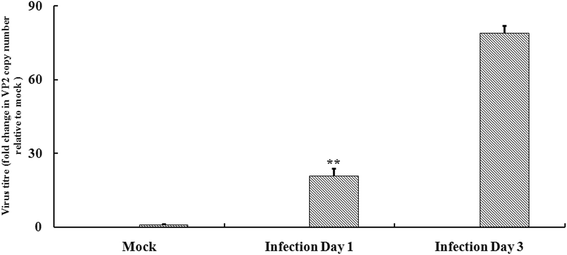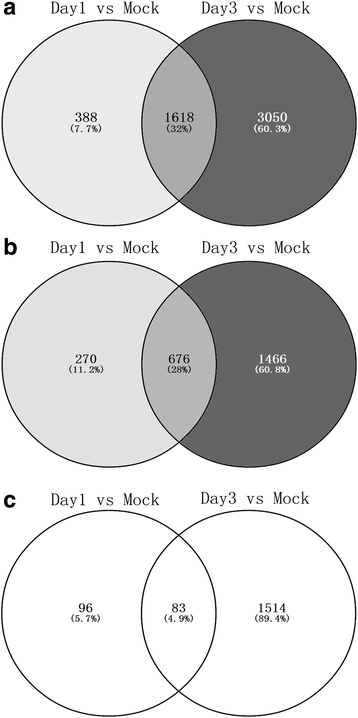Transcription profiles of the responses of chicken bursae of Fabricius to IBDV in different timing phases
- PMID: 28486945
- PMCID: PMC5424287
- DOI: 10.1186/s12985-017-0757-x
Transcription profiles of the responses of chicken bursae of Fabricius to IBDV in different timing phases
Abstract
Background: Infectious bursal disease virus (IBDV) infection causes immunosuppression in chickens and increases their susceptibility to secondary infections. To explore the interaction between host and IBDV, RNA-Seq was applied to analyse the transcriptional profiles of the responses of chickens' bursas of Fabricius in the early stage of IBDV infection.
Results: The results displayed that a total of 15546 genes were identified in the chicken bursa libraries. Among the annotated genes, there were 2006 and 4668 differentially expressed genes in the infection group compared with the mock group on day 1 and day 3 post inoculation (1 and 3 dpi), respectively. Moreover, there were 676 common up-regulated and 83 common down-regulated genes in the bursae taken from the chickens infected with IBDV on both 1 and 3 dpi. Meanwhile, there were also some characteristic differentially expressed genes on 1 and 3 dpi. On day 1 after inoculation with IBDV, host responses mainly displayed immune response processes, while metabolic pathways played an important role on day three post infection. Six genes were confirmed by quantitative reverse transcription-PCR.
Conclusions: In conclusion, the differential gene expression profile demonstrated with RNA-Seq might offer a better understanding of the molecular interactions between host and IBDV during the early stage of infection.
Keywords: Bursa of Fabricius; Chicken; Infectious bursal disease virus; RNA-Seq; Transcription profiles.
Figures



Similar articles
-
Differences in genetic background influence the induction of innate and acquired immune responses in chickens depending on the virulence of the infecting infectious bursal disease virus (IBDV) strain.Vet Immunol Immunopathol. 2010 May 15;135(1-2):79-92. doi: 10.1016/j.vetimm.2009.11.005. Epub 2009 Nov 18. Vet Immunol Immunopathol. 2010. PMID: 20005576
-
Differential modulation of immune response and cytokine profiles in the bursae and spleen of chickens infected with very virulent infectious bursal disease virus.BMC Vet Res. 2015 Mar 25;11:75. doi: 10.1186/s12917-015-0377-x. BMC Vet Res. 2015. PMID: 25884204 Free PMC article.
-
Infectious bursal disease virus: strains that differ in virulence differentially modulate the innate immune response to infection in the chicken bursa.Viral Immunol. 2006 Spring;19(1):83-91. doi: 10.1089/vim.2006.19.83. Viral Immunol. 2006. PMID: 16553553
-
Infectious Bursal Disease: a complex host-pathogen interaction.Dev Comp Immunol. 2013 Nov;41(3):429-38. doi: 10.1016/j.dci.2013.03.017. Epub 2013 Apr 6. Dev Comp Immunol. 2013. PMID: 23567344 Review.
-
Dynamic alterations in T-lymphocyte subsets assessed by flow cytometry in chickens following exposure to infectious bursal disease virus: A systematic review.Dev Comp Immunol. 2025 Jan;162:105280. doi: 10.1016/j.dci.2024.105280. Epub 2024 Oct 11. Dev Comp Immunol. 2025. PMID: 39396690
Cited by
-
Genome-wide analysis of differentially expressed mRNAs, lncRNAs, and circRNAs in chicken bursae of Fabricius during infection with very virulent infectious bursal disease virus.BMC Genomics. 2020 Oct 19;21(1):724. doi: 10.1186/s12864-020-07129-1. BMC Genomics. 2020. PMID: 33076825 Free PMC article.
-
Immunoprotective role of LaSota vaccine under immunosuppressive conditions in chicken challenged with velogenic avian avulavirus-1.Trop Anim Health Prod. 2019 Jul;51(6):1357-1365. doi: 10.1007/s11250-019-01814-4. Epub 2019 Jan 31. Trop Anim Health Prod. 2019. PMID: 30706330
-
Bioinformatic identification and expression analysis of the chicken B cell lymphoma (BCL) gene.Genes Genomics. 2019 Oct;41(10):1195-1206. doi: 10.1007/s13258-019-00849-z. Epub 2019 Jul 16. Genes Genomics. 2019. PMID: 31313104
-
Identification of Reference Genes in Chicken Intraepithelial Lymphocyte Natural Killer Cells Infected with Very-virulent Infectious Bursal Disease Virus.Sci Rep. 2020 May 22;10(1):8561. doi: 10.1038/s41598-020-65474-3. Sci Rep. 2020. PMID: 32444639 Free PMC article.
-
Bacillus amyloliquefaciens TL Downregulates the Ileal Expression of Genes Involved in Immune Responses in Broiler Chickens to Improve Growth Performance.Microorganisms. 2021 Feb 13;9(2):382. doi: 10.3390/microorganisms9020382. Microorganisms. 2021. PMID: 33668643 Free PMC article.
References
-
- Ruby T, Whittaker C, Withers DR, Chelbi-Alix MK, Morin V, Oudin A, Young JR, Zoorob R. Transcriptional profiling reveals a possible role for the timing of the inflammatory response in determining susceptibility to a viral infection. J Virol. 2006;80(18):9207–9216. doi: 10.1128/JVI.00929-06. - DOI - PMC - PubMed
MeSH terms
Substances
LinkOut - more resources
Full Text Sources
Other Literature Sources
Molecular Biology Databases

